#tayū
Explore tagged Tumblr posts
Text
Aoi Tayuu kamuro's

2 notes
·
View notes
Text
Notarou Tayuu-san ( Narinder reincarnated) follows his daughter’s suggestion to take a look at this “webtoon” thing.
He immediately regrets it





#original post#original art#cult of the lamb#cotl#alternate universe#original character#cotl au#cotl oc#kinda#it’s just Nari in another life#tayū#oiran#japanese clothes#japanese#kimono#webtoon#art meme
4 notes
·
View notes
Text
When I die, do not burn me, do not bury me
Throw me into a field, so I may fill the bellies of the starving dogs.
Jigoku Tayū
6 notes
·
View notes
Text
Design Analysis: Kouyou Ozaki

Have you ever wondered why everyone has assumed Kouyou to be a courtesan or brothel owner when there has been no specification in the main series?
First, there is the fact she refers to herself using “wacchi” (��っち), a pronoun that had been used by Geisha and Oiran alike in the Edo Period. Second is that, while she doesn’t have as many layers or hair ornaments, her large Obi is still tied at the front, and wears a Uchikake over her kimono. An Uchikake by itself is not an indicator, but I would think she has it to accentuate what she’s meant to resemble.
An Oiran is a general term for a high-ranking courtesan who has taken up some traditional arts and refined in their entertainment skills, putting them above the common prostitute. The term “Oiran” (花魁) means “flower leader”. It was said to be used by Kamuro and Shinzo to refer to the older courtesans and eventually became their title. It is theorized to come from the phrase "oira no tokoro no nēsan" (おいらの所の姉さん), but there is no exact and official origin of why they’re referred to as such.
They are exclusive because of their price ranges and the highest ranking had a degree of choice in who they had in their company. They get confused with Geisha often because of their similar skill sets and when you don’t know what you’re looking for visually, but in addition, this is mostly the fault of the Occupation of Japan with many coupling both of them into what they’d call “Geesha Girls” and mistaking Geishas for prostitutes. Many even called themselves a Geisha to bring in business, but Geisha’s legally couldn’t promote sex (that didn’t stop them though sometimes if they needed the cash). They are not distinctive only because one of them can practice sex work and the other cannot. Besides my previous comments on accessories, layering, and their distinctive Obi, Oirans have more extravagant coloring and designs on their clothing.
Not to be confused with the Tayū, whom Oiran had taken after in their clothing. Tayū are not as relevant in pop culture, so do not worry about trying to tell the difference in fictional media because they’re 100% going to be an Oiran unless specified. If you would like to learn more about Tayū and not look at confusing wiki pages, I recommend reading these: Karyukai Workers and Roles, The Look of Oiran Versus Tayuu, and this nice video about a modern day Tayū.
While Shinzo are the new debuting girls late into their training, a stage before that is the Kamuro. Kamuro are young girls sold by their parents to either pay off debts or have fewer mouths to feed, and some were even born into it. On the surface, the deal of their daughter becoming someone so luxurious was desirable and made it easier for them to give her away, but not all of them got that life and had to fight for that position. Kamuro were put under the care of senior courtesans who would teach them the skills they’d need while Kamuro did their chores for them. Kamuro were also considered a social marker of how rich the courtesan was to be able to provide for these girls, but they were limited to only caring for two. It was an exploitative and abusive industry that groomed them into this life. These girls can’t leave because they’re stuck to a never-ending contract that they need to pay off in their work because of the costs of their living, so competition for the top spot wasn’t only for the idealized life promised, but to get a higher paying customer to pay off their contract to escape.
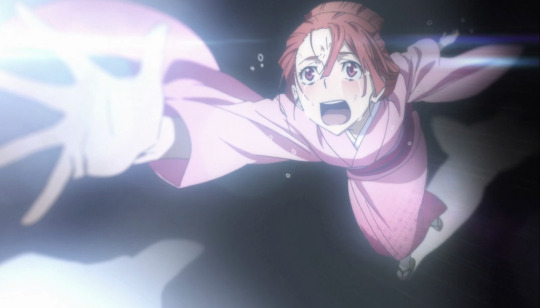
Kouyou’s backstory is heart-wrenching in this context. We don’t have details of how she ended up there or the rest of what happened, but you can’t deny the resemblance between the life of a young girl in the red light district trying to escape her conditions with a man who has promised her freedom and Kouyou wanting to live in the light outside of the Port Mafia’s unlivable darkness with someone who wanted to show her that. Along the same lines, Kyouka can be seen as a Kamuro that Kouyou has taken under her wing and wanted to leave herself. Granted, using sexual favors is manipulation 101 and she could’ve learned this anywhere, but it would make sense if she had learned this from Kouyou as a courtesan. Kamuro weren’t ignorant of what their “Older Sisters” did.
There are many differences between the life of these girls and the bloody one Kouyou had lived in the Port Mafia, and it’s not as if I’m implying she had lived the life they did as we don’t know much, but the similarities can’t be just coincidence. As for “brothel owner”, the Yakuza unsurprisingly stick their nose into the sex work business, so it wouldn’t be too hard to assume Kouyou was looking over these things.
Side comment: “Ane-san” is old-fashioned, so the only time you’ll see it be used instead of just “Ane” or “Onee-san” is in a historical context, or with the Yakuza to refer to the upper echelon female members.
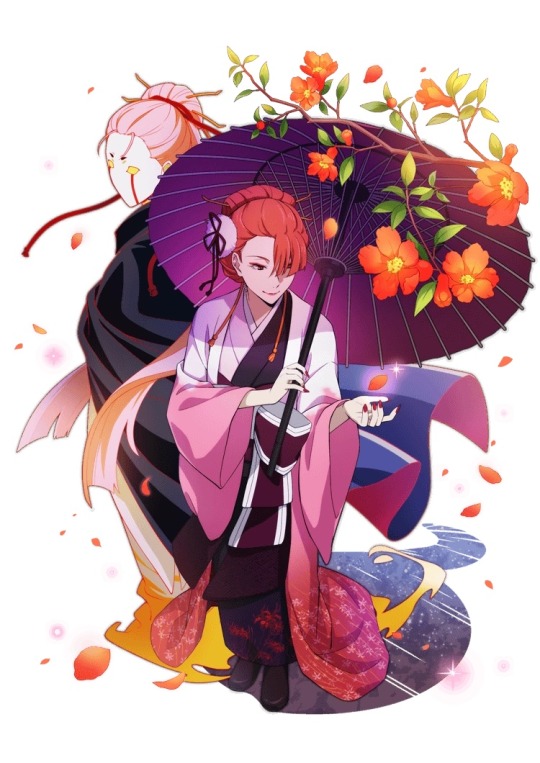
(I refuse to use something not from mayoi, bones art… is ugly)
Kouyou’s crimson hair comes from her name “紅葉”, which can be translated to “Red (Autumn) Leaf”, or roughly “Crimson Blade”. It’s referred to as crimson in the light novels, but we all want to call it deep pink. Either way, both colors are deep-seated in love and she wears it all over. Her uchikake starts light at the top and deepens the lush cherry blossom pink into a bloody red where it drags at the floor with trailing bellflowers (or some type of thin petaled bellflower). Her inner kimono is pure black, except at her shoulder where only a piece of pink is left, and at the bottom are prominent red spider lilies. Their color is emphasized with a transitioning dark shade of purple.
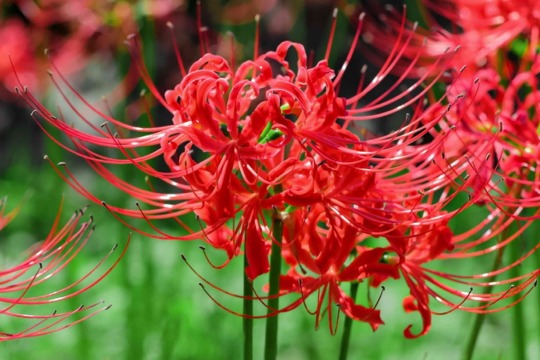
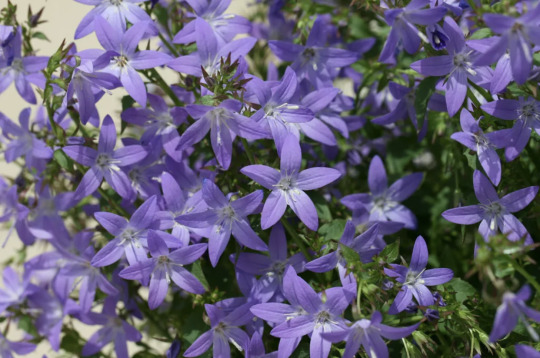
Red spider lilies are infamous because of their connotation with death, but there’s more to it. They’re considered “hell flowers” and could lead the dead to reincarnation. Used in funerals, legends say that seeing someone you will never meet again will have these flowers bloom in your path. They’re flowers that bloom in autumn and the meanings they have are: painful memories, abandonment, passion, independence, giving up, longing, and “never to meet again”.
Kouyou is a mournful soul whose past has never left her, especially in the face of confronting Kyouka’s choice. For these flowers to appear in the inner darkness of her design is significant to how deeply his death had affected her, but also the abandonment of what she regards as her “born nature”. That man had wanted to show her light but had only contributed to the growing darkness that she wasn’t allowed to escape. She had died that day with him, and could only keep walking in the flower field of death she had created. It’s only the piece of light on her shoulder that is left of her past self.
Now, the bellflowers on her uchikake can mean: Loyalty, gratitude, faithful, unchanging, honesty, and discipline.
If the Port Mafia had once been a place of terror and misery, then Mori had changed that for her and made the Port Mafia her home. She is forever grateful for what he has done to make this life livable again and dawns this flower gracefully with light colors. She chooses to wear these light colors over her kimono because even if she resents the hypocrisy of the people who can live in the light without criticism, she still wants some semblance of that dream after her soul has been blackened to that gain. Harukawa, when designing these characters, keeps in mind what organization and type of person they are when color coding them. It’s also with the understanding of what shades will appear darker and lighter in the manga style. Harukawa says that she made sure to give Kouyou light colors and kept her eye from being dark to signify that she’s a good person.


In the manga, her outfit is slightly different from the anime’s design. Her uchikake is paler and does not have any flowers on it, and the flowers on her kimono are much more... vague, so if there are better candidates than my guesses, then be my guest and throw me a bone. From the silhouettes, I will assume that the largest visible flower is a water lily and/or lotus and the flowers growing on the branches are sakura blossoms and/or plum blossoms. It’s fitting considering she is introduced with sakura blossoms falling around her, but they could be plum blossoms too as “花魁” can refer to them in some cases.

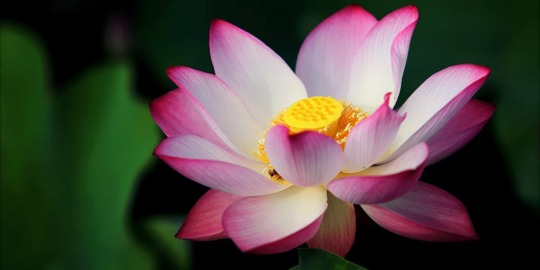
Water lilies and Lotus flowers are very recognizable, and I’m sure most of you have seen them around. Their meaning of “purity of heart” comes from how wild water lilies will usually be white. Similarly, lotus flowers are seen as pure because they can bloom in mud without staining themselves. Other meanings water lilies are given are: Rebirth, trust, faith, and kindness. With lotus flowers, they are: Rebirth (again), “to change someone’s mind”, “eases suffering (of the heart)”, and resilience.
Ignoring the meaning of faith and trust since we had already gone over it with the bellflowers, both possible flowers emphasize her good nature and the renewal of life that Mori had blessed her with. Mori had eased the mindless suffering caused by the old boss and changed her mind about what the Port Mafia was to her. She pushed through the muddy waters of the old boss’s darkness and stood her place well in her strength.
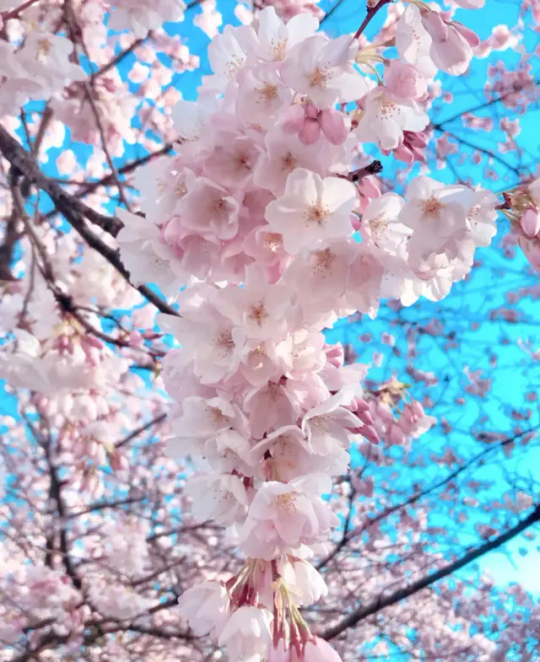
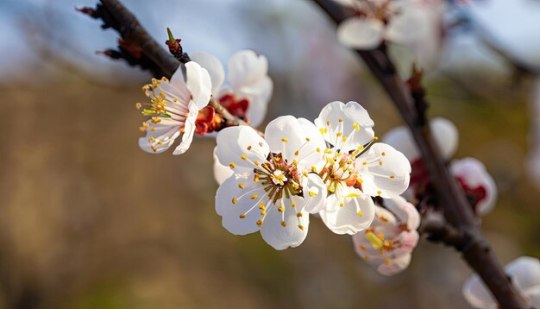
Sakura blossoms and plum blossoms introduce two different meanings in their symbolic usage. Plum blossoms bloom in the winter cold in the signal of spring coming, showing the prosperity of life in the hardest of conditions, while sakura blossoms remind us of life’s impermanence and that its beauty can only last for so long. Plum blossoms also can mean: elegance, nobleness, patience, loyalty, hope, and renewal. If these are Sakura blossoms, then they can mean: renewal (again), violence, and hope (again).
In the context of these flowers appearing on her kimono, they mean something different than the renewal of a new era Mori had brought. The remark at the beginning of chapter 17 gives us a personal meaning for Kouyou to what sakura flowers are to her. They are the blooming hope of a girl’s wishes, but they eventually have to drop not long after growing up and facing their reality. Remaining a bud is impossible, so Kouyou, in defiance of this eventual fate of this girl, sees slashing the girl’s heart to be more merciful than the long, doomed drop they all have to face. Kouyou is a bloomed Sakura flower who has already dropped, and her change had started there, not when she bloomed. Even if a part of her had died, she still clings with no real hope.
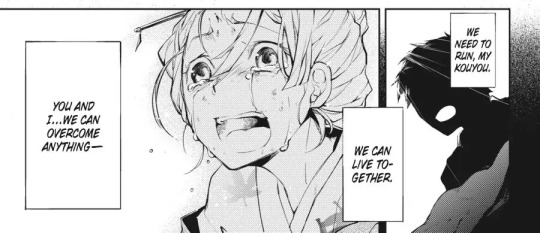
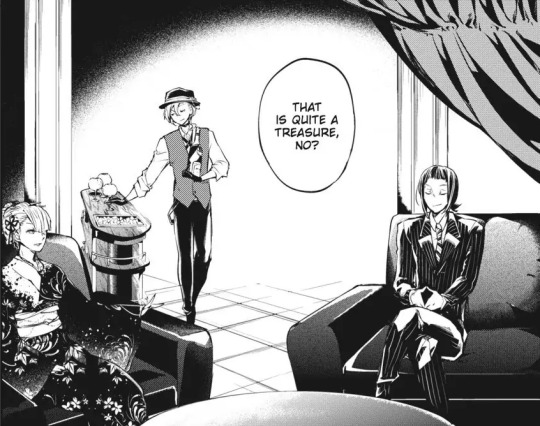
This is the only image we have of her kimono without anything covering it. This is right at the end of the Guild Arc where they are celebrating their accomplishment. Kouyou sheds her outer bright colors because there is no room for that in this setting and trusts Chuuya and Mori enough to shed any pretenses. They’ve all dressed casually, so she would too. The leaves are meant to be red maple leaves that also show up in the flashback of Kouyou of you look carefully. As I’ve said before, these have to do with her name. The vague firework-like design that shows up are either enlarged spider lilies or chrysanthemum flowers. Assuming these are the white kind, they mean: truth, loyal love, admiration, and sincere heart. However, the yellow kind can mean “slighted love”.
She is sincere inside and out, even if some of that sincerity isn't as pretty as what it looks like from a distance. “A flower that blooms in the dark can only survive within the dark” is a sentiment she lives by after all. If it is a yellow chrysanthemum, then its meaning is what you’d expect from her lonely heart.
Bonus round
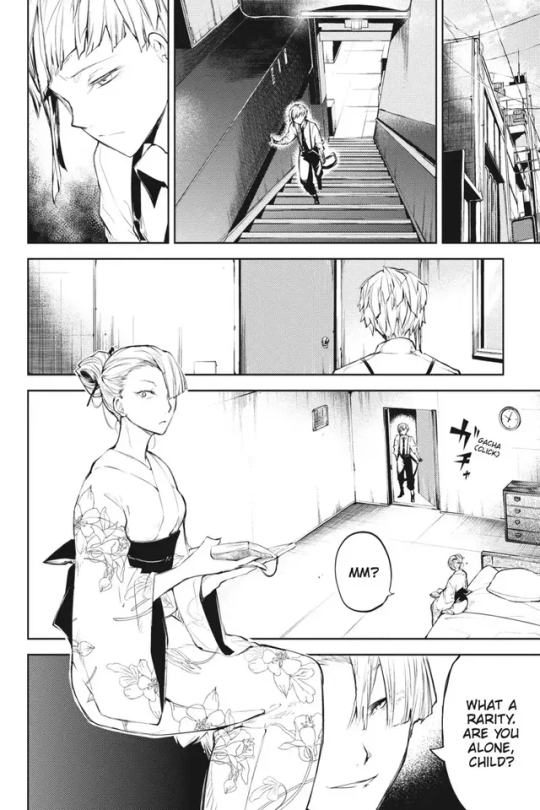
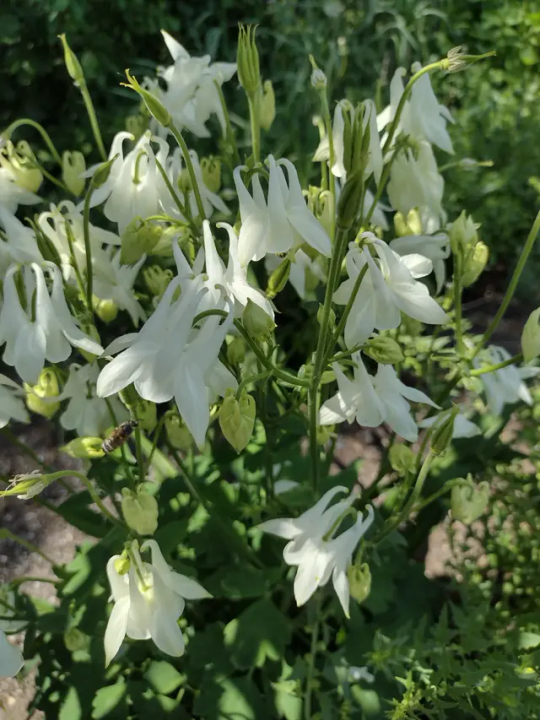
Welcome if you have read this far, this is where I stray from her main outfit and talk about outfits that only appear once. This first kimono is what she wore when staying put in the Armed Detective Agency’s capture so that Kyouka would be able to live out a dream she can’t bring herself to live out. The white kimono is covered with columbine flowers. They can mean: risk-taking, good fortune, faith, folly, hope, and specifically for white columbines, “I’m concerned for this person”. Negative/inverse meanings include: The emblem of deceived lovers, ingratitude, and faithlessness.
What this means in Kouyou’s overall situation shouldn’t be too mind-boggling. She is in this room for Kyouka’s sake and is fairly concerned about how this plan of many risks will play out, but has faith in Dazai’s abilities. She is her most stripped version of herself and works with good intentions with Dazai under this idea, so she only wears light. Kouyou though is only left to her thoughts, her own past in that room. She is glad for Kyouka, but it only leaves fear that Atsushi won't be able to live up to something he promised so she ensures that he is committed to helping her into the light and strong in a way that man wasn't able to be.

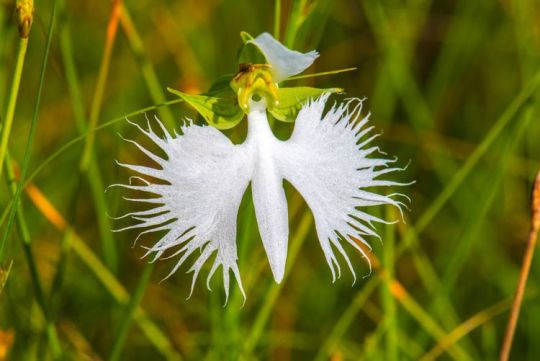
The second one is from the chapter art with Kouyou and Mori leading Soukoku away from each other. It’s an outfit that reflects her mindset during her time with the old boss, an inverted palette from what she’s currently wearing. She hasn’t fully embraced her environment yet. Unfortunately, almost all of the flowers and plants are a bit too vague for me to point out. There is only one flower I think I recognize on her right sleeve that looks like a bird, and it is called an Egret Orchid. The only meaning of significance here is: “I think of you even in my dreams.” Some sources will say, “My thoughts will follow you into your dreams”, but I think this made more sense in this context.
This sentiment is regarding that man who had told her such an innocent lie. She not only hid her sorrowful, pure yet broken heart inside the guise of flowering darkness but weaponized this sorrow in her violence and climbed the ranks of the Port Mafia. He is a source of regret, hate, and sadness. He is her only semblance of what hope and love could resemble, and it has become a corrupted and negative thing to her in his death. Pure darkness is the only thing can trust for people like her… but she still ponders what that life will be. His influence had never left her, whether it was for better or worse.
—
Alright um
I don’t typically do analysis like this as I don’t find clothing all that interesting to look into, but there is merit to thinking about what a character is wearing even on a surface level. It can be a show of their social rank, their job, their interests, their personalties, their culture, etc. but there isn’t always a deeper meaning to their clothing on a theming sense and I can’t find it in me to usually be interested in doing it myself. In most media, the clothing only indicates the era the characters are from and how marketable they can be.
Luckily, BSD is one of those stories that do put heavy consideration on what the characters are wearing and how their clothing changes overtime for some. Obvious examples include Harukawa’s color pallet consideration to indicate what type of person they are and what organization they are from, Dazai’s clothing swap when he leaves the Port Mafia, Chuuya’s many outfits as show of his growth in belonging to the Port Mafia, the coat passed down from Mori to Dazai to Akutagawa, and the Yin-Yang coloring of Atsushi and Akutagawa that stays consistent even in Beast where they swap.
When doing clothing analysis you’re almost expected to overanalyze and stray into your own interpretations of what certain things mean, when sometimes there isn’t any intended meaning. None of that is a bad thing though! You don’t have to rely on an author or artistic word to analyze a thing, but I tend to have a hard time with just making claims like that. So I picked this concept for Kouyou because I have my own ideas for the thought process behind her design that felt right and find it intriguing enough to share. I had actually asked a friend if I could take her from their hands since they had been planning to do their own clothing analysis, but got stuck. So thank you for letting me steal it!
I’m not a historian or whatever, but I do like sharing what I do know about certain topics! Unexpectedly, this took more out of me than I thought. I’ve written more in a shorter time, but I got stuck with having to write about one certain topic than the character entirely. I will probably never do something like this again, at least not with flower meanings. Who knew how much work it was to actually explain what they mean in context in such a big bunch?
The day I finish that Odasaku analysis is when I’ll read The Golden Demon.
#bungou stray dogs#bsd#kyouka izumi#ozaki kouyou#analysis#bsd analysis#bsd meta#no more…#*looks back at my huge pile of reading I have to do*#FUCKK
295 notes
·
View notes
Note
Hi! Lately, I have been very interested in Maiko/ Geiko and Yujō/Oiran/Tayū culture, their differences, but the most popular known books, documentaries have so many lies and discrepancies. I hope you might know some answers.
I don’t know if you read “Autobiography of a geisha” by Masuda Sayo, but she described her life as a hot-springs geisha during W2. While she learned “gei” (art), what happened to her was truly not different from prostitution. She was given different points after sleeping with men depending whether he was her danna, someone else’s danna or just a random guy.
There is this whole thing about American soldiers thinking “geisha” meant “prostitute”, bc some of the prostitutes decided to dress as geisha to attract more customers, I suppose?
Then, what Americans thought wasn’t exactly wrong (if we are not looking at Kyoto or Osaka)? Or was Masuda Sayo just a prostitute and she herself didn’t even know about it?
Are geisha outside of major districts (idk how to call them, Ponchoto, Gion Kobu etc) not considered geisha? Were times just so difficult that geisha had to resolve to prostitution under a banner of love instead of money, so it doesn’t make it illegal? Did Masuda just lie?
Masuda Sayo wrote the book herself in freaking Kanji, I believe her more than what “foreigners”, who only lived in geisha district for a couple of months, managed to understand. And Mineko Iwasaki was a queen among the geisha of completely different time period. I am more curious about how life was for “third rate” geisha.
I guess I am just somewhat confused about the statement that “Geisha are not prostitutes”, while there is an account that poor country girls sold in shitty okiyas were in fact as good as prostitutes.
In specific areas of Japan there used to be "double registered" geisha; that is, they were registered by the government to work as both geisha and as prostitutes. However, there were areas that worked under these double registration rules but didn't have official registration, so pretty much anything went. Sayo Masuda worked in one of those areas. These areas were often in small seaside towns or resort villages, which lead to onsen geisha having a tainted name that endures to this day. What they considered a geisha may as well have been night and day from what was going on in the large cities that had proper geisha associations that actually looked out for their members. This isn't to say that districts like Gion Kobu or Pontocho were perfect as at the time that Masuda was active young girls were still being sold into the karyukai across the country. So, where geisha populations were large and in larger cities they were primarily just geisha who, by government law, could not engage in prostitution. However, in small towns and villages, those who were identifying themselves as geisha also often took part in prostitution on the side as it was sadly a way for them to "serve" their customers. Sayo Masuda also wrote her autobiography in hiragana, not kanji, as she couldn't read or write kanji since she never had a formal education. American GIs brought back stories of "geesha girls" due to women who were not geisha but used one of the only Japanese words that they knew to have sex with for money in order to survive after the war. The Americans had no idea what a real geisha looked like and the karyukai didn't reopen (if they weren't bombed to shreds) until 1947. So, there were two years of regular women calling themselves geisha having sex with GIs that really didn't help with the Western perspective of geisha. By the time that Mineko Iwasaki came along, which was decades after Masuda was active and the Americans had mostly pulled out of Japan, prostitution had been made illegal across the country, so no double registered geisha existed anymore and no geisha anywhere were supposed to be having sex on the side for money (sex on the side is fine as long as it's consensual between two adults and no money is being exchanged though). Since geisha are incredibly exclusive for the most part, it's far cheaper and easier to hire a call girl or a hostess if someone wants to have illegal sex in Japan (it would be naïve to say that it doesn't happen even though it's illegal). So, were there different "levels" of geisha when Sayo Masuda was active? Of course. Was she lying? I don't believe so. Her story is extremely compelling and detailed to the point where it would be hard to be made up. Were the lines blurred on what was a "geisha" prior to World War II? Depending on where you were, yes. Has the karyukai changed drastically since that time? Very much so. Is there still work to be done when it comes to how geisha are perceived both inside and outside of Japan? Indeed, there's quite a great deal. But, we all have to start somewhere and I hope that this has helped to answer your questions ^^
63 notes
·
View notes
Text

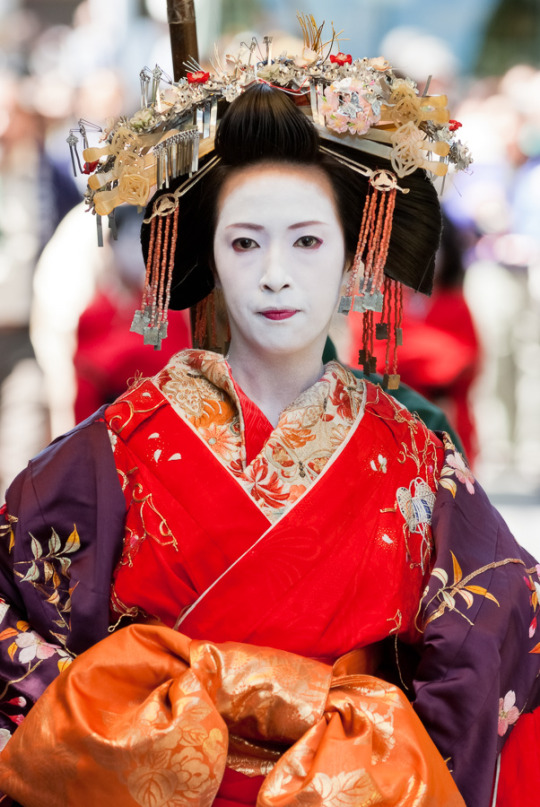
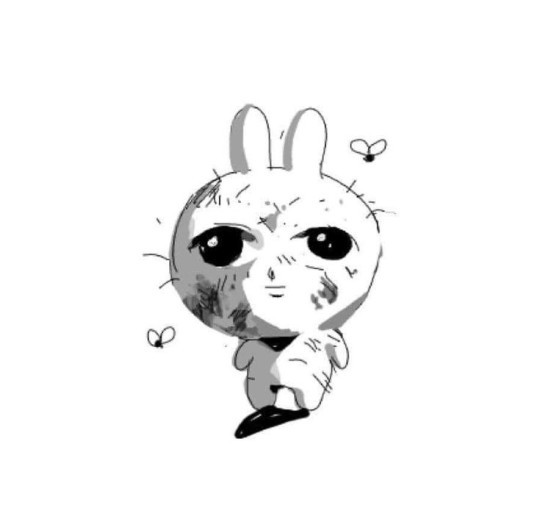
Maybe I'm too excited, I'll fix my accessories
And also, I'm going to have to create some scenes from scratch, the district arch is difficult to have backgrounds that I haven't already seen on Pinterest in low quality
(And this is a REAL tayū :³)
62 notes
·
View notes
Text
Takayuki "Tayū" Kanataro

Male / 23-ish / Bassist in a band / 5'7" ft
This is Takayuki! My Todomatsu selfship OC. I made him a while ago, but never really did anything with him... But now I can! Huzzah!
This reference isn't a lot, I rushed it... But I finally made him one after, like, half a year-ish?
*Edit, changed a bit on his nude ref to fit more with how his bottom surgery would have went.
More info under the cut
First born son of a wealthy family. His family owns a music company, in which they sell musical instruments of many kinds. They have a shop in Tokyo, which was also the first shop to be set up. They have been selling musical instruments to customers for forty years. By the time the company has turned 20-ish, Takayuki was born, and so was his love for music. His whole life he was surrounded by music. His mother would teach him piano after school. As he grew up, he would get incresingly tired of the piano, so he gives up on the music front for a while. After attending a live show, his eyes landed on the bassist and how they cool they looked. That’s what inspired him to pick up the bass. At 15, he bought himself a bass. He would practice with it every day. He then decided to join the jazz club in high school to show off his skills.
Right now, he's the bassist for a band named RATE OF DECAY. He's also written a few songs of his own during his time in the band. The band is comprised of him, his sister, and a few of his friends.
Honestly, I mainly made him because there's a big lack of Todomatsu selfshippers... Where y'all at! (*´Д`*)
#おそ松さん#osomatsu san#ososan#osmt#mr. osomatsu#mr osomatsu#mister osomatsu#osmt oc#ososan oc#ocmatsu#osomatsu san oc#osomatsu oc#oc x canon#oc#yumematsu#yumeship#Takayuki Kanataro#art
13 notes
·
View notes
Text
Oiran!AU Veronica

Ok so this AU has me in a chokehold—
And now I'm gonna talk about Veronica's place in this AU, as well as Victor, and Cater and Malleus
So yeah if you wanna read me infodumping a LOT about Yoshiwara in the Edo period, my thoughts are under the cut
I'll just get Malleus out of the way first since I talked briefly about him in Irina's parts
But basically, I imagine him to be a daimyo (warlord). And as for how he came to meet Irina, I'm imagining Lilia basically just kinda signed him up for it so Malleus could have some more interaction with people in general
And now to Veronica, and also Victor!
So in this AU I'm imagining that after losing their parents and moving in with their adoptive father, a famine, followed by a plague, swept through the area where they lived. And with their adoptive father basically on death's door, and having nothing for the twins to eat, when a representative of a brothel in Yoshiwara came and offered to basically buy the twins, he couldn't really refuse. They would be sent someplace where they could actually eat, after all.
But they were separated. I haven't decided yet where Victor would end up, but probably not somewhere super nice. And Veronica ended up in Yoshiwara, as the Kamuro (the 'little sisters' I talked about) to a Tayū. And she eventually became a Tayū herself.
And now! Time to learn about yet another new term:
Tayū / 太夫
Tayū were the highest ranking of the courtesans in Yoshiwara, and were very beautiful, skilled at arts and intelligent, since they were specifically meant to be courtesans to the very tippy-top elite men in society, like powerful samurai, daimyo, or even imperial princes. So there were very, very high standards for them!
As for Veronica and how she feels about being a Tayū...
She absolutely hates it. She hates the thought of people she hasn't become comfortable with touching her.
But what she hates the most is the fact that her job is basically to lie to people and say she loves them.
She is literally allergic to the words 'I love you' and I could not imagine her saying them, even to a partner, until after DECADES of being together
She is BLUNT. Honest to the point of being an absolute asshole because she just hates holding back her thoughts.
But... When she became a Tayū, she was also assigned Kamuro of her own. And it's her responsibility now to care for them.
So for their sake, she swallows her pride and does her best at a job she hates. She has more people to think about than just herself. So she stopped swearing. Started pretending to be someone she wasn't.
And as someone who values her individuality and prizes her identity above all else, that was really, really difficult for her. Every day, she feared she was losing another part of herself.
And that's when Cater comes into the picture somehow; I haven't quite worked out how they'd meet yet.
But anyway!
Now I get to talk about a very, very interesting concept called 'Wakashu'. I'm not gonna be going too far into it, but the basic gist is that it was kinda like a 3d gender; in basic terms, Wakashu was kinda like the 'pupa' stage in the metaphorical caterpillar-butterfly cycle of a man's life, where he wasn't exactly a 'child' but not an adult either, and it was usually from around age 11 to the mid 20s. In this age range, boys' features were more feminine than later on in life- though it of course depends on the person. And so it wasn't uncommon for older men to have relationships with Wakashu in the 15-mid 20s age range.
And these Wakashu, after women were banned from being kabuki actors, often took on the female roles in kabuki plays, since their more feminine features made it easier for them to convincingly pretend to be a woman.
And in Yoshiwara, that often ended up translating into these Kabuki Wakashu being prostitutes themselves, or as they were called: 'Kagema'. Though eventually Kagema just came to mean 'male prostitute' in general.
And many Kagema worked at teahouses, especially once set up near kabuki theatres. A way to think of it is as... You know how some people go to Hollywood to try to make it, and then they see this place saying 'hey, here you can train your skills' and so they get a job there but the job ends up just being sex work of some kind. Kinda like that.
Basically, it's giving 'Last Night in Soho' vibes.
So yeah! That's where I imagine Cater in this AU.
What's worse is that for some people, they were sold into it by their parents. So, since I myself imagine canon Cater's home life to be/have been...not the best...I do see that as something his parents would do; in this AU at least.
And some teahouses, known as 'Ageya' were also the places were Tayū and Oiran in general met with clients!
So I'm imagining Cater and Veronica would end up meeting because they often ended up conducting their trades in the same teahouse.
And I'm imagining they get to talking eventually, because of it. And being in such similar situations, they quickly become pretty comfortable around each other, and dropping the facades they need to wear all the time for their work.
And as for Victor... Regardless of where he originally ended up, he somehow found his way to where Veronica worked in Yoshiwara, and he became one of her attendants. And now he 'gets rid of' any clients she doesn't like :) They've always protected each other, after all.
And if she's being pressured by a client to give them a lock of her hair, or a fingernail (yes that really happened), Victor just goes to rob a grave about it, sparing her from having to actually go through with it herself
Tag list: @another-random-paradise @thehollowwriter @faefum @cactus13-rolloflammesimp @beneathsakurashade
@nyx-of-night @theolivetree123 @babyghoul138 @skibidibabygirl @screamintoad
#oiran!au#🐝veronica#🩸victor#cater diamond#moony's ocs#malleus draconia#twst oc#twisted wonderland oc#👁️👁️hngggg…dragon boy#catonica ♦️x🐝
15 notes
·
View notes
Text

╭【 🍒・ MATSUMOTO 】 ・・
・┈ ✦ ﹕: Kōgyokū Tayū displaying her plum blossom kanzashi for the first day of February!
╰╮


#geisha#maiko#japan#geiko#japanese#tayu#shimabara#kamuro#shoume#geimaiko#imvugeisha#imvu#imvu roleplay
7 notes
·
View notes
Text
Mizu x Apothecary Diaries style ❤️
A cover I drew for my fanfic I’ve been writing 🥺 Out now if you wanna read 👋
Summary: What if the meteor didn't crash and Mizu ends up with Madame Kaji instead of sword father? Mizu gets sold to Madame Kaji and becomes her daughter.

31 notes
·
View notes
Text

Nishitani for the end of pride month
Idea from @rggtattoos
Skeletons from the artwork by Kawanabe Kyōsai about Jigoku tayū
124 notes
·
View notes
Text
Aoi Tayuu [the video's and photo's are not mine !!]

1 note
·
View note
Text
dearest mutuals, will you please go on a walk in the traditional japanese city of kyoto with me, wearing the prettiest of kimonos and drinking in the sights? watching the tayū perform, admiring the 1,200-year-old kiyomizu buddhist temple and its sights? take photos in jidaiya arashiyama's photo studio, dressing up as oiran, or maybe samurai? just enjoying ourselves. that's it. @theballadeers-blog @frozen-waters @right-tavern @charliesharkx @buttter-dog @xirqda @pursuedbyamemoryy @long-lost-soul @tahitiansiguesss @your-rdo-gf @wrongplacerighttime
17 notes
·
View notes
Note
Do you have any information about tayū?
I do know some things about Tayû, but definitely not as much as about Geiko/Maiko. Is there anything specific you want to know?
Also make sure to check out @geimaiko - despite the blog name, you will find a lot of stuff on various Tayû related topics over there!
7 notes
·
View notes
Note
Hey! Sorry if you already answered this, but I was wondering about this obi I sometimes see on oiran/ tayuu? I know it's not the usual obi knot they wear.

also, are tayuu required to wear red kimono at all times? Thanks!
I've tried looking into it and the only things I could find were that tayū didn't wear that type of knot, only oiran, and that I can't seem to find a concrete name for it. As to the red kimono, yes, tayū always wear a red kimono underneath their uchikake. Red was once a symbol of the nobility, of which the tayū actually were one, and allowed them to gain admittance to the royal palace ^^
37 notes
·
View notes
Text



So, remember when I said "the Oni version of my oc doesn't have clothes, and you all going to help me decide"? I have been researching to have references of what I had in mind. Tayū, as far as I understand, they are women of the highest artistic rank, just like the Oirans (so she and Daki can be friends :3)🎉
One detail I wanted to add, I've been planning to maybe do a small animation involving Matsu as this Oni, but I'm afraid it will take a while to see the light of day (who's fault is that?)
and as always, I can add or remove details, it's not the final product yet, I still want to adjust the colors and props, but I want you to have an idea of what I have to cook🤫
(Remember, I'm merely using the idea of the Tayū, which I don't master, as I discovered them recently, if I do something wrong, let me know and I'll fix it)
40 notes
·
View notes